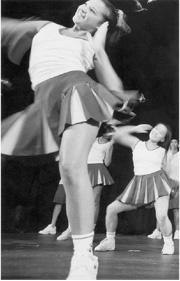France seems almost like Tacoma in Olivier Assayas’ A New Life. The opening shot takes place in a Costco-like warehouse where our beautiful young protagonist, Tina (Sophie Aubry in ripped denim and uncombed hair; she’d be great on a CD cover), works as a stock clerk. Next we see Tina’s messy apartment, which she shares with her baggy-eyed, manic-depressive mom, whose string of affairs has produced three children from three different fathers. After tidying up and yelling at Maman for being so pathetic, Tina goes out to meet her boyfriend at a crowded McDonald’s.
Assayas, whose recent spoof of French New Wave cinema, Irma Vep (1996), bored half of its film-festival audiences, shows more subtlety and aptitude for visual narrative in the 1994 Life—but he doesn’t make it easy.
Shot in a slow, steady rhythm by which even a bloody blow to the head plays out like a ballet step, Life doesn’t so much tell the story of Tina as show the results of an unseen chain of events. Major changes occur between scenes, and how the characters got to point B from A is left to the audience’s conjecture. Tina goes from driving the forklift at the stockroom to being passed out underneath a coffee table in a posh condo. She’s awakened by a man who says to her cryptically, “We are both in a dubious position. . . . You didn’t have to set the carpet on fire.” He is Constantin, the lawyer and adviser of Tina’s father, Ludovic, and he warns Tina against seeking out Ludovic or her half-sister Lise. Tina, still weak from her pill overdose, defies his advice, falls asleep in the guest room, and proceeds to camp out at the condo.
Ludovic turns out to be a one-dimensional character, a wealthy prick who has no interest in helping Tina. “I didn’t love your mother. We lived together for a while, but I never loved her. . . . You won’t get anything from me,” he tells her with as much feeling as if he were declining a telemarketer’s pitch. Tina doesn’t stay away, however. She establishes a relationship with the initially reluctant Lise, which leads to a transformation not unlike that of Julia Roberts’ character in Pretty Woman. She starts wearing Lise’s yuppie clothes and curls her hair. Then she sleeps with Constantin and eventually moves into a condo of her own. In such ways, Assayas shows how the two women’s lives are divided by a thin line. Both slim and beautiful, Tina and Lise aren’t separated so much by education or upbringing as they are by the amount of support the men around them give.
Assayas’ stylish camera angles and poetic timing make the two women look sexy when they’re lighting cigarettes or pouring water into a teapot. His scenes of people actually having sex, however, are just plain awkward. When Constantin’s wife and a young rogue are getting it on, the guy stops to get a condom, but doesn’t bother to take his jacket off. It’s as if Assayas is making fun of the notion of French l’amour altogether.






